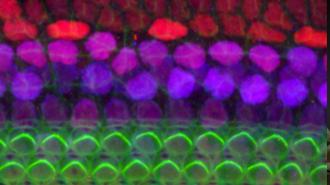Gene therapy looks like a promising way to restore hearing in people, but it’s very hard to get the therapy into the part of the ear it needs to reach. Now, a new study has unlocked a “backdoor” into the inner ear that could make administering the therapies less risky.
The challenge: Hair cells are tiny receptors in the ear that convert vibrations into electrical signals our brains can interpret as sound. We’re born with about 16,000 in each cochlea, but over time, some are damaged or killed by disease, aging, and exposure to loud noises.
Piercing the temporal bone to deliver a gene therapy could cause further damage and hearing loss.
This is a common cause of hearing loss, and while there’s currently no way to reverse hair cell damage in people, researchers have managed to trigger regeneration and restore hearing in mice by injecting gene therapies into their cochleas.
Among the many challenges in translating these gene therapies to people is the fact that the cochlea is embedded within the temporal bone in adults, and piercing it to deliver a gene therapy could cause further damage and hearing loss.
A way in: Researchers at University of Rochester recently took a closer look at the cochlear aqueduct, a tiny channel between the cochlea and the brain, in both people and mice.
For their study, now published in Science Translational Medicine, they used imaging and modeling tech to map the flow of cerebrospinal fluid from various parts of the brain through the aqueduct and into cochlea.
“These findings … may represent an important step towards using gene therapy to restore hearing in humans.”
Maiken Nedergaard
Based on this, they hypothesized that a gene therapy designed to restore hearing in deaf mice would end up in a mouse’s cochlea if they injected it into a reservoir of cerebrospinal fluid at the base of the animal’s skull.
And they were right. The adeno-associated virus carrying their gene therapy reached the inner ear, increasing the production of a protein that restored hearing in the deaf mice. The ability of this gene therapy to restore hearing was known prior to this study, but what this shows is that there is a potentially safer, less damaging way to get it to the cochlea.
The bottom line: While we still don’t know whether this will work in people, finding a better administration route could help ensure researchers don’t accidentally cause more damage if any of the treatments make it to clinical trials.
“These findings demonstrate that cerebrospinal fluid transport comprises an accessible route for gene delivery to the adult inner ear and may represent an important step towards using gene therapy to restore hearing in humans,” said senior author Maiken Nedergaard.
We’d love to hear from you! If you have a comment about this article or if you have a tip for a future Freethink story, please email us at [email protected].






